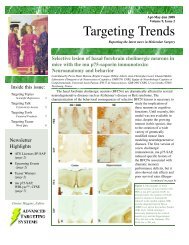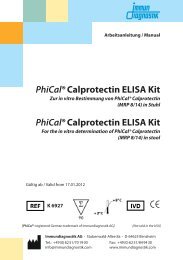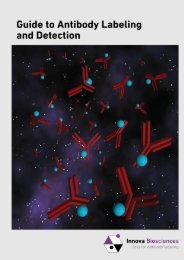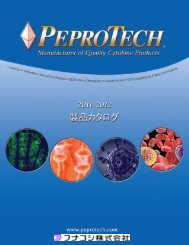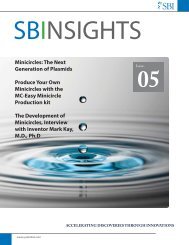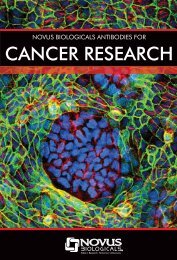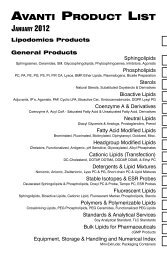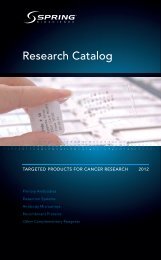Thermo Scientific Pierce Crosslinking Technical Handbook
Thermo Scientific Pierce Crosslinking Technical Handbook
Thermo Scientific Pierce Crosslinking Technical Handbook
Create successful ePaper yourself
Turn your PDF publications into a flip-book with our unique Google optimized e-Paper software.
<strong>Crosslinking</strong> Applications<br />
DNA/RNA crosslinking to proteins<br />
<strong>Crosslinking</strong> of DNA or RNA to proteins is more limited because<br />
the reactivities of most crosslinkers favor protein:protein crosslinking<br />
over protein:DNA crosslinking. To assist in these crosslinking<br />
methods, DNA probes are often synthesized with primary amines<br />
or thiols attached to specific bases. After insertion of the bases<br />
into DNA, amine- or sulfhydryl-reactive crosslinkers can be used<br />
for their conjugation to proteins. EDC has been reportedly used<br />
to crosslink RNA to ribosomal protein subunits. Other specialized<br />
chemistries are reviewed in Hermanson’s book, Bioconjugate<br />
Techniques, 2nd Edition (Product # 20036).<br />
Label transfer<br />
Label transfer involves crosslinking interacting molecules (i.e.,<br />
bait and prey proteins) with a labeled crosslinking agent and then<br />
cleaving the linkage between bait and prey such that the label<br />
remains attached to the prey (Figure 1, page 7). This method allows<br />
a label to be transferred from a known protein to an unknown,<br />
interacting protein. The label can then be used to purify and/or<br />
detect the interacting protein. Label transfer is particularly valuable<br />
because of its ability to identify proteins that interact weakly or<br />
transiently with the protein of interest. New non-isotopic reagents<br />
and methods continue to make this technique more accessible and<br />
simple to perform by any researcher.<br />
Traditional label transfer reagents<br />
The earliest examples of label transfer reagents incorporated a<br />
photoreactive phenyl azide group that contained a hydroxy-phenyl<br />
modification on the ring. The phenolic hydroxyl activates the ring<br />
for substitution reactions to occur ortho or para to its position.<br />
These compounds can be radioiodinated using typical oxidation<br />
reagents such as chloramine T or <strong>Thermo</strong> <strong>Scientific</strong> <strong>Pierce</strong><br />
Iodination Beads (Product # 28665, 28666). Iodination of the crosslinker<br />
with 125 I prior to its use will result in a radioactive label<br />
transfer reagent that can tag an unknown interacting protein<br />
with a radiolabel after cleavage of the crosslinker’s spacer arm.<br />
In practice, the crosslinker is first radioiodinated and then reacted<br />
with a bait protein, typically through available amine groups. This<br />
modified protein is then introduced into a sample and allowed to<br />
interact with other proteins. The sample is exposed to UV light to<br />
photo-crosslink the interacting complex. At this point, the label can<br />
facilitate detection of the interacting proteins or the complex can<br />
be cleaved and the radiolabel transferred to the protein interacting<br />
with the bait. The now radiolabelled, unknown protein(s) can be<br />
detected by autoradiography after separation by electrophoresis<br />
and Western transfer. The first reagents employed using this<br />
method were bifunctional. They were designed such that the<br />
photoreactive moiety bears the transferable label. These molecules<br />
are either amine-reactive or sulfhydryl-reactive and are labeled<br />
radioisotopically with 125 I. More recent offerings have been prepared<br />
as trifunctional reagents that more adequately segregate the<br />
reactive sites from the label. These trifunctional reagents can be<br />
designed to include non-radioisotopic labels such as biotin.<br />
<strong>Thermo</strong> <strong>Scientific</strong> <strong>Pierce</strong> APDP: radiolabel transfer reagent<br />
APDP (Product # 27720) is a heterobifunctional crosslinker<br />
containing a photoreactive group that can be labeled with 125 I.<br />
APDP contains the sulfhydryl-reactive pyridyl-dithio group. The<br />
sulfhydryl-reactive group of APDP offers the advantage of allowing<br />
the course of the bait protein coupling to be monitored by<br />
following the loss of the 2-pyridyl-thione moiety (leaving group).<br />
The 2-pyridyl-thione can be detected at 343 nm (extinction<br />
coefficient: 8.08 x 10 3 M -1 cm -1 ).<br />
Disadvantages of traditional bifunctional label transfer reagents<br />
Although these reagents have been used successfully to obtain<br />
data on protein interactions, they possess some inherent<br />
deficiencies compared to trifunctional reagents designed for<br />
label transfer applications. The user should be aware of the<br />
following characteristics of these reagents.<br />
1. Photoreactive and labeled chemical groups are the same.<br />
2. They require labeling with 125 I before use, and the efficiency of<br />
label incorporation is low.<br />
3. The photoactivation step can result in several unproductive<br />
pathways that lower crosslinking yield between bait and prey.<br />
4. The 125 I label can be released during the light reaction, causing<br />
nonspecific labeling of the protein(s) in the mix.<br />
<strong>Thermo</strong> <strong>Scientific</strong> <strong>Pierce</strong> SAED: fluorescent label transfer reagent<br />
Subsequent designs of bifunctional label transfer reagents used<br />
nonradioactive labels to avoid the safety issues posed by 125 I.<br />
Fluorescent constituents designed into cleavable photoreactive<br />
crosslinkers make possible transfer of a fluorescent label to an<br />
unknown interacting protein. An example of this type of reagent<br />
that incorporates a coumarin group is SAED (Product # 33030),<br />
which has been substituted with an azido group on the aromatic,<br />
photoreactive ring. The reagent is non-fluorescent prior to exposure<br />
to UV light, but upon photolyzing and coupling to interacting<br />
proteins, it becomes highly fluorescent. The reagent also has a<br />
disulfide bond that can be reduced, resulting in cleavage of the<br />
crosslinked proteins and transfer of the label to the unknown<br />
interacting species. In this case, the fluorescently labeled<br />
interacting proteins can be followed in cells to determine the<br />
site of interactions or the fate of the proteins after interacting.<br />
<strong>Thermo</strong> <strong>Scientific</strong> <strong>Pierce</strong> SFAD: fluorine label transfer reagent<br />
SFAD (Product # 27719) is a heterobifunctional crosslinker containing<br />
an amine-reactive NHS-ester moiety at one end and a photoreactive<br />
perfluorophenyl azide moiety at the other end, separated<br />
by a cleavable disulfide bond. The presence of fluorine allows<br />
the label transfer process to be monitored by 19 F NMR. Also the<br />
improved stability of the perfluoroaryl nitrene-reactive intermediate<br />
provides additional efficiency of insertion into C-H bonds compared<br />
to the amine nucleophile reaction typical of non-fluorinated aryl<br />
nitrenes that quickly undergo ring expansion.<br />
6<br />
For more information, or to download product instructions, visit www.thermo.com/pierce



